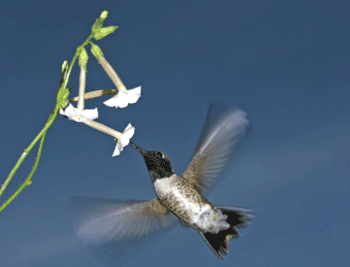Plants manipulate birds and insects with a carefully balanced mixture of chemicals
Flowers include repellent aromas as well as attractants in their finely tuned mix of scents to maximise their chance of reproducing, according to a new study by researchers in Germany. A complex bouquet of scents initially attract birds and insects to the flower, but repellent notes stop all the nectar being taken by a single pollinator, the scientists say.
The group, led by Ian Baldwin at the Max Planck Institute for Chemical Ecology in Jena, had already discovered that tobacco flowers’ most potent chemical attractant is benzyl acetone, and their most important repellent is nicotine. But why flowers would produce poisonous nicotine in their petals had remained a mystery.
In the new study, the researchers used RNA interference - a gene silencing technique - to block the biosynthetic pathway of each scent chemical to see how that affected the plant’s ability to reproduce.
’This is the first study to look at the plant’s chemical control of pollination,’ says Baldwin. ’We video-monitored the plants to find [which pollinators] were visiting them. But key to this study was showing how these chemicals affect the plants’ fitness, or ability to reproduce.’

Baldwin’s team found that both attractant and repellent chemicals were needed by the plants to ’optimise’ pollination by insects and hummingbirds - enticing them to the flowers but persuading them to leave enough nectar for other visitors. They also carried out a type of botanic paternity testing to find which plants had been most successful at producing seeds.
’These plants can self-pollinate, so we had to distinguish self-pollination from out-crossing,’ explains Baldwin. ’We developed an antherectomy procedure - which is basically a vasectomy on a plant - making a slit in the side of the anther tube and removing the anther heads. We then genotyped the seeds to find out who the father was.
’The whole world of pollination biology was looking at it from the insect’s perspective, rather than the plant’s. Pollination is a complex activity, and every individual involved has its own agenda. The plant must play all sorts of sophisticated games in order to be pollinated but not have its nectar robbed.’
Robert Raguso from Cornell University studies the chemical communication between plants and their pollinators. ’This is a nice example of a chemically mediated pull-push strategy, which has seldom been considered by pollination biologists. And the combination of targeted gene silencing with experiments that measured the reproductive consequences of the manipulation sets a new standard,’ he says. ’In this case, plants appear to have the upper hand on their floral visitors.’
Victoria Gill
References
et al, Science321, 1200 (DOI: 10.1126/science.1160072)






No comments yet